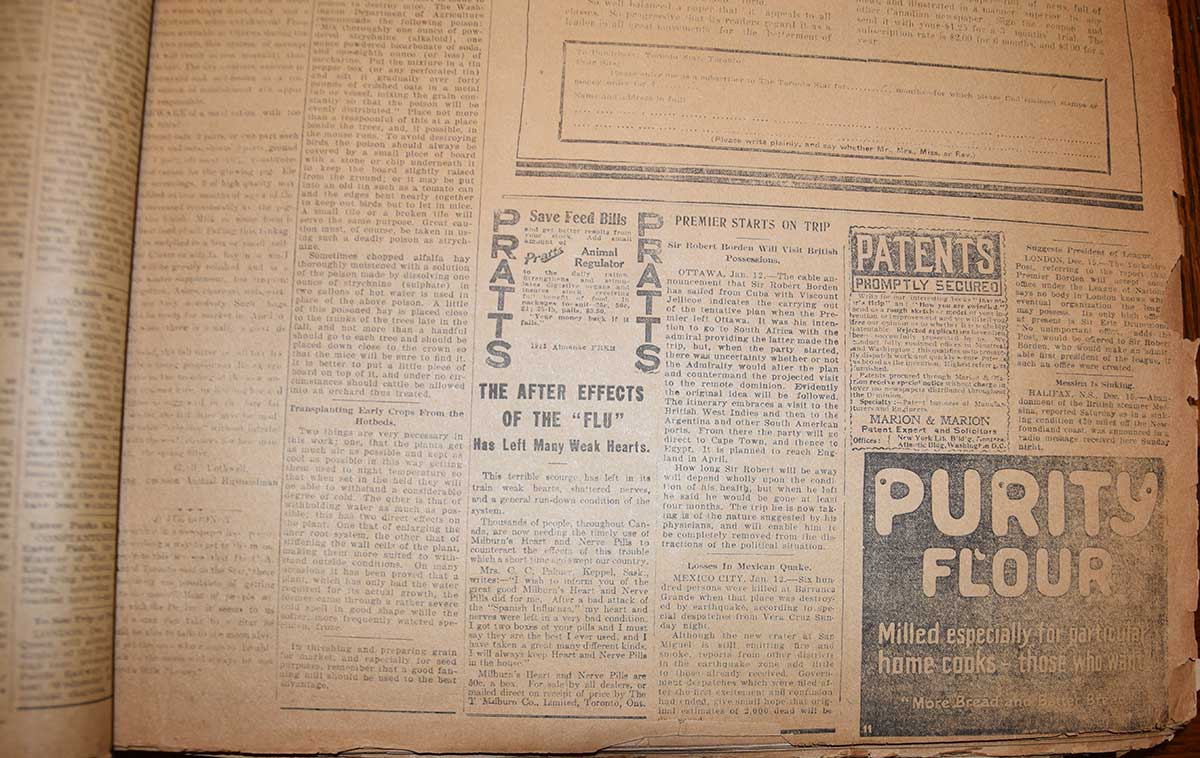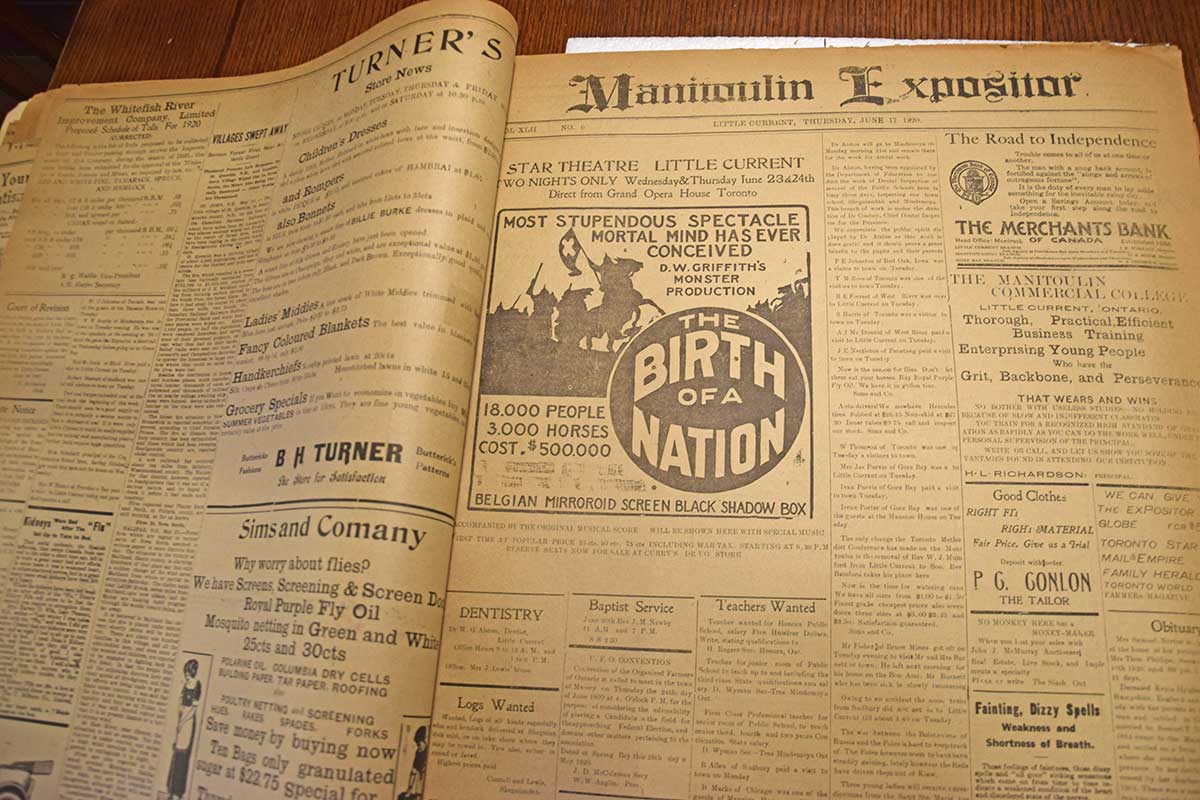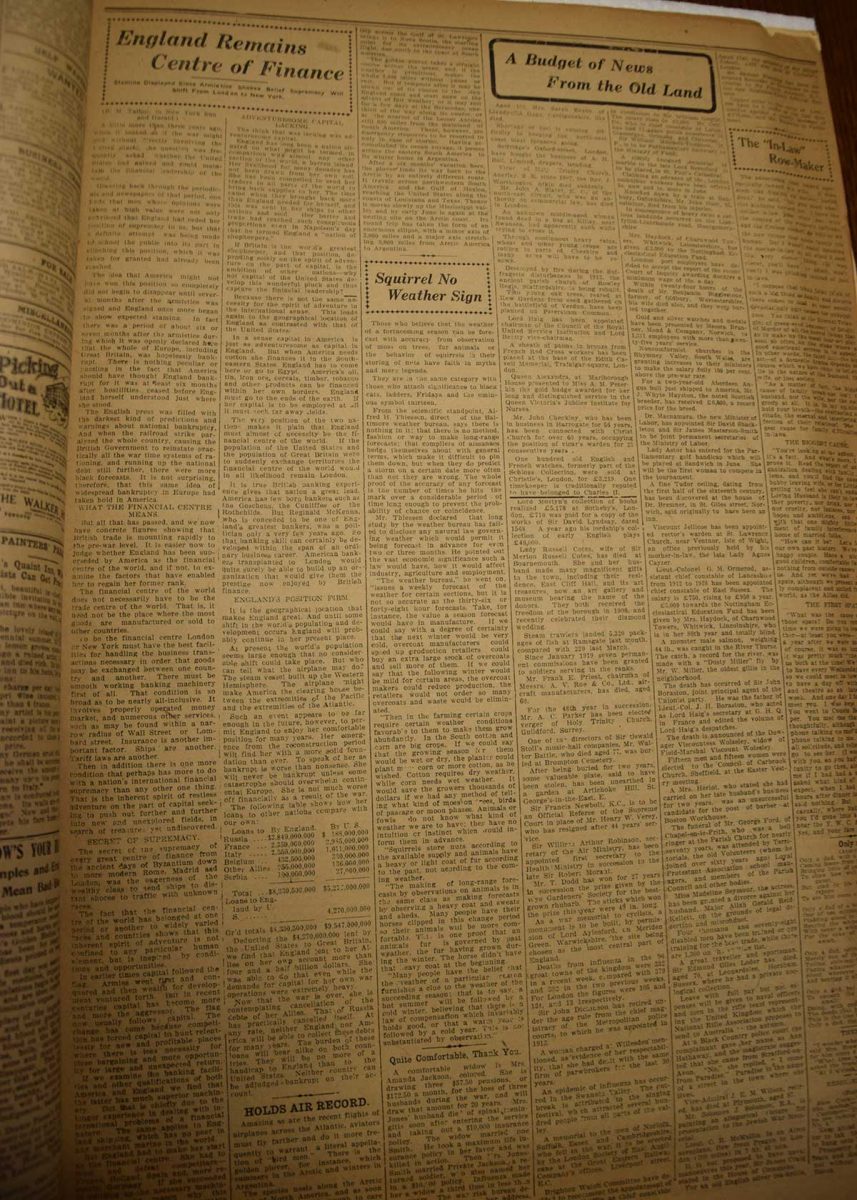A century ago, Expositor focused on Spanish flu after effects
MANITOULIN – This week’s edition of The Manitoulin Expositor marks the 141st volume of the oldest continuously printed community newspaper in the province as it proudly continues its role as Manitoulin’s newspaper of record. For 141 years, The Expositor has contained within its pages the stories that matter most to Islanders, a local resource for both Island residents and those of its sons and daughters spread across the globe. To mark the occasion, Expositor scribe Michael Erskine delved into the archives to explore the view from a century past, digging into the paper’s pages from the year 1920.
Researching the past through the pages of the paper is usually a straightforward, if somewhat time perilous activity. For the Little Current-based writer, the task usually involves a trip to the Northeast Town public library and feeding the appropriate roll of film into the microfilm reader. In times of pandemic such as ours the process has become somewhat more convoluted as direct access to the library’s archives is off limits.
Hard copies of The Expositor are safely entrusted in the custody of the Assiginack Museum in Manitowaning, but that source is also currently unavailable to the public. Thankfully, Assiginack Museum curator Kelsey Maguire agreed to release the desired 1920 volume along with extreme cautionary admonitions—with good reason. Over the course of the intervening 100 years, the ancient paper has grown delicate and brittle requiring both a gentle touch and gloved hands (to prevent oils from further damaging the fragile pages).
But once the paper was carefully removed from its Styrofoam encasement and laid out upon the table, new perils could await any unwary time traveller bent on researching any specific topic as a myriad of rabbit holes open across the pages. Luckily, this expedition is more of a broad exploration where diversions from a focussed path are not as dangerous to the time at hand.
The Expositor of 1920 was a very different creature to that of today. Published on a Thursday in those days, one of the first things noted upon glancing at the faded coffee coloured front page of the January 22 edition is the surprising lack of news, neither local, national nor international happenings of note jump out and headlines are barely larger or bolder than the body text. Instead, the opening stanzas are advertisements for products as diverse as cars and pianos, while notices of found heifers and advertisements seeking domestic help lie scattered about the field.
Today’s Expositor is dominated by local news, with Manitoulin events of note that have taken place on Manitoulin receiving full place of honour upon both the front and third pages. If international or provincial news is to be found, it is generally viewed through an Island lens.
In 1920, The Expositor, like many local papers of the day, provided windows into what was happening across the globe, the nation and the province—still referred to in those days as Old (southern) and New (Northern) Ontario. Most of the stories contained within the 1920 edition were brazenly culled from the pages of the Toronto Star, Globe and Mail and New York Times—often with formal partnering, such as subscription bundles offering the Island paper with subscriptions to those grander urban news portals.
But there are still plenty of nuggets of insight to be found.
The paper of 1920 is filled with stories of what would become known as The Troubles, the struggle for Irish independence and the bloody activities of Sinn Fein, the rebels seeking to throw off the yoke of the still dominant British Empire. The lens is definitely pro-Empire, reflecting no doubt the staunchly British antecedents of the nation of the time, at least in Upper Canada.

A series of photos featured in consecutive editions of the paper chronicled a visit by the then (and future King Edward VIII of England) the Prince of Wales. Notable is that the luminaries in the photos were so familiar to the readers of the newspapers of the day that they remained uncaptioned.
News from the Old Land was a regular feature in the paper, chronicling the latest tidbits of scandal and other happenings in Britain.
The war in Europe is still echoing through the pages, as the footsteps of the deposed and exiled Kaiser are traced across the landscape of the Low Country, while the nascent footsteps of the League of Nations (precursor to the United Nations) already can be seen faltering even as the ink on its birth announcement was being prepared.
One insightful bit of news was that women had been admitted, as students, to the Temple in London, an apparently historic event.
The globe was still recovering from an earlier pandemic, the Spanish Flu that had rampaged from 1918 to 1919, its legacy still reverberating in the press through advertisements for medications for nerve and heart pills aimed at alleviating its after effects—perhaps shades of things to come in the next couple of years.
Nerves were very much on everyone’s mind in those days, at least if judging from plethora of advertisements aimed at alleviating the condition—with special attention to the frailty of the “weaker sex.” But doubtless the shattered nerves of those who had so recently served in the trenches and the strains the war placed on those left behind at home proved a fertile ground for many remedies and treatments littering the pages.
The Cold War was still a generation away, but one story from the New York Sun raises alarm about the Red influence in the education system, asserting that there was “no place so unfit for anarchist and bolshevism as behind the teacher’s desk.” The fall of Odessa to the Reds was among the news of the day. No less a luminary than Winston Churchill was advising the Western nations to intervene in the war in what was soon to become the Soviet Union.
Echoes of today’s front page stories can be found as they ripple forward in time. Notably concerns about the impact that the diversions planned at Chicago would have on Great Lakes water levels could be found, proving a point made by the late Barney Turner when the waters last dropped to alarmingly low levels: “The water goes up and the water goes down, and it is always a big deal.” It was in 1920 that Mr. Turner’s namesake passed on, joining what was then often referred to as the great majority.
The new Indian Act hailed the enfranchisement as citizens of Indigenous peoples, referred to as Indians, and was touted as an avenue for Natives to become full members of society. Often, it noted, bands were reluctant to give permission for an individual Native to become a citizen as they considered themselves sovereign nations bound to Canada by treaty. Enfranchisement was seen as an encroachment on treaty rights and is still seen in that light by many Anishinaabe, accounting in part for the traditionally low voter turnout among reserve residents to this day.
Another regular feature from the Spirit of St. George purported to support the English language in natural history and called for the union of Anglo-Saxon races. It was indeed a most different time—but chewing Wrigley’s gum, “electrically sealed, sealed tight, kept right” was apparently a popular pastime, especially while watching the epic ‘Birth of a Nation’ at Little Current’s Star Theatre. Mexican cigars, as “good as those costing as much as five cents in America” could be had for as little as 2.5 cents.

The beauty of Canada’s newly constructed Parliament buildings were extolled in one article while the latest in spring hats were announced in what today would be labelled an advertorial.
The curious case of one C.R. Atkinson occupied a prominent place in two consecutive editions. The first noted that the prominent Little Current lawyer had expired at the dinner table while laughing heartily at something his wife had read to him from the pages of The Expositor. Luckily for the paper, and somewhat less so for his unfortunate spouse, the next edition clarified that he had expired “due to complications of indigestion.”
Yet another article spoke of the “kick” that came from consuming peyote and topics as diverse as the proper grooming of a horse to the baking of eggs informed the reader. Did we mention rabbit holes? In any event, the article describing the baking of eggs, as opposed to boiling, asserts the baked item is quite delicious and superior—odd that the practice has not descended to the present day.
Remarkable among the stories are the names and families recorded that continue on to today’s editions of The Expositor, but far more so than even that is how much more focus on local events and happenings are to be discovered in your local newspaper of record. So join us as we celebrate a happy birthday to Ontario’s oldest community newspaper as we look forward to another 141 years of serving our readers, near and far.







